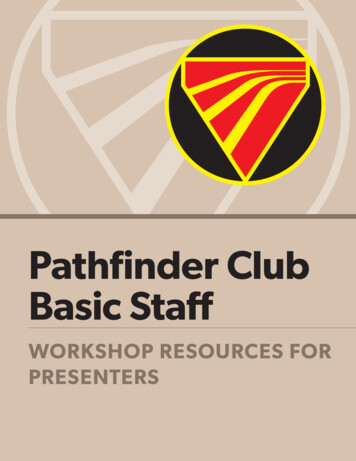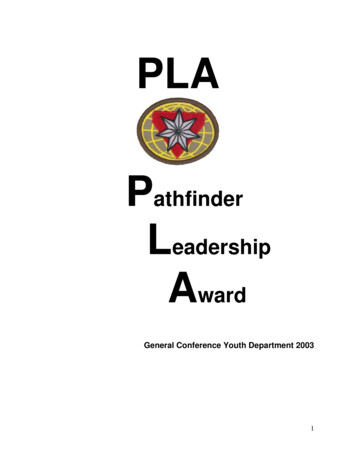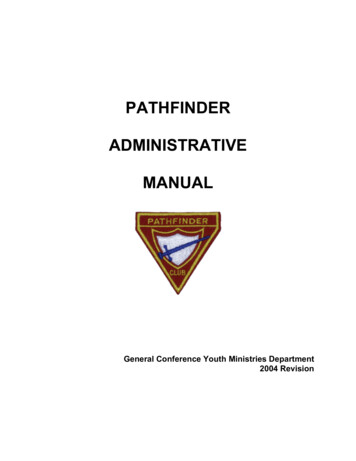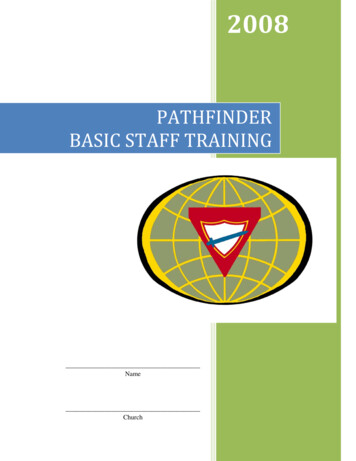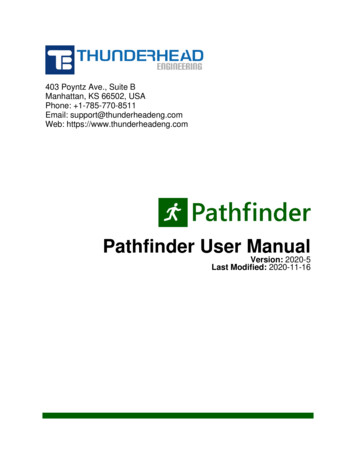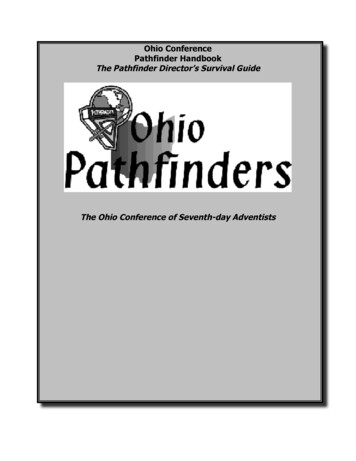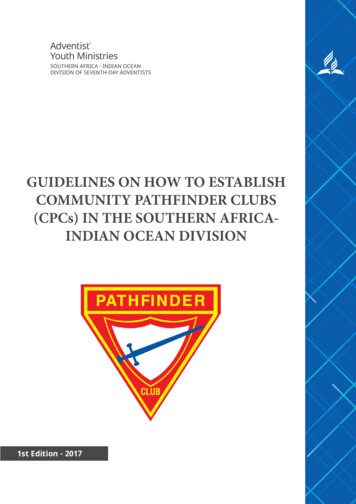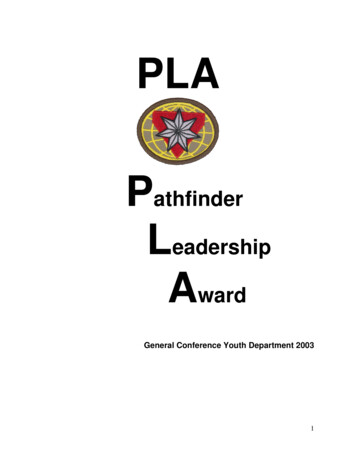
Transcription
PLAPathfinderLeadershipAwardGeneral Conference Youth Department 20031
IntroductionYou now hold in your hands Part Two of the most current leadership development programfor youth ministry in the Seventh-day Adventist Church. This concept uses the Master Guide as thefoundation for junior youth ministry leadership, then builds two levels of continuing education whichwill help keep youth leaders sharp, up-to-date, and focused on why we are in this business.Part Two-- Pathfinder Leadership Award (PLA)Once the Master Guide level has been completed, most leaders feel they “have arrived” andnow have the necessary tools to properly guide their youth through the varied programs the churchhas for its youth. This feeling of adequacy may last a short time or for quite a while, but sooner orlater one begins to sense that unnecessary mistakes are being made; that the world continues butsomehow “I got left behind.” Also, in many areas of the world there are now in place laws whichrequire continuing education on the part of anyone who works with young people, be they paidemployees or volunteers. Generally, this expected continuing education can be in the form of youthrelated workshops/seminars to be attended on a periodic basis. There is also a growing group ofpersons who have put in many years of service to local clubs and are now being asked to share thoseyears of experience and expertise with other clubs as “Area Coordinators” (or other similar titles). Itbecomes easy for these people to begin living in the past and get out-of-touch with the realities of thepresent. Getting out-of-touch is even easier for church-paid employees– namely, youth departmentdirectors, at all levels from local fields/conferences to the General Conference.The purpose of this level of continuing education is to 1) continue equipping people for asharper Pathfinder ministry and 2) enable those who are finding themselves removed from reality tokeep pace. Again, there is a refocus on personal spiritual growth, which must be a never-endingupward path. There are also several seminars of advanced-level leadership development andopportunity for practical application of lessons learned.Part One-- Master GuideThis continues to be the highest level of leadership within the Adventurer/Pathfinderprograms of the church. It focuses on one’s personal spiritual life and growth first and foremost.General leadership skills are then woven into the sharpening of those skills which are specificallygeared to leading youth in God-ordained areas of development: understanding God’s world of nature,outreach ministry, service to others, and a life-style which denotes healthy living.As one church leader of the past simply put it: “You can’t teach what you don’t know, andyou can’t lead where you won’t go.” As leaders we must not be good at only spouting theory if weexpect to see success with our youth ministry; we must live what we preach and demonstrate.Part Three-- Advanced Pathfinder Leadership Award (APLA) (Pathfinder InstructorAward– PIA)This level is heavy on training the trainers– Area Coordinators and others who will be2
involved in helping local club leadership be as focused and sharp as possible. Persons who attemptthis level must be approved by the local conference youth department, which would imply that thesepersons are already living exemplary Seventh-day Adventist Christian lives. They qualify as truerole models in their daily living, in leadership, and in all Pathfinder-related skills. The skills learnedduring this level of continuing education will enable the candidate to clearly present the very best ofknowledge in the very best of ways so that club leadership will gain the maximum benefit –implying, therefore, that the children receiving the actual development process might truly becomethe very best youth in the world. It should be true, indeed, at every investiture that “these symbolspresented represent the very highest ideals of the church for its youth.”Parts One and Three are available from the same source you obtained this manual. So, now,welcome to the Pathfinder Leadership Award. Enjoy the avenues of continued learning and discoveryahead, and may God bless you as you continue your ministry to God’s children.General Conference Youth Department, 20033
Pathfinder Leadership AwardI. Prerequisites1. Be a Master Guide.2. Have completed a Pathfinder Basic Staff Training Course withinthe past three years.3. Be an active Pathfinder staff member.4. Be an active Pathfinder Class and/or Honor curriculum instructor.Page6666II. Personal Growth1. Complete a Bible Year plan or the Encounter Series II, Christ theChurch.2. Read a book on self-esteem, adolescent development orinterpersonal relationships.3. Select and develop a new personal skill useful to Pathfinder ministrythrough reading, listening to tapes, attending a class or joining aspecialized organization.4. Hold a current Red Cross CPR certificate or its equivalent.6677III. Skills Development1. Increase your Pathfindering skills by attending the following scheduledminimum hours for each seminar as sponsored by the conferencePathfinder Ministries personnel.A. Administration and Human Relations.8 hours1. Team Building .(3 hours)a. Goal settingb. Planning processc. Motivating volunteers2. Personal Improvement .(2 hours)a. Know your temperamentb. Finding your purposec. Conflict resolution3. Development of Faith in Pathfinder Growth .(1 hour)a. Preadolescent and adolescent growth patternsb. What makes adolescents tickc. Discipleship through mentoring4. Discipline .(1 hour)a. Understanding disciplineb. Effective disciplinec. Christian discipline5. Current Issues .(1 hour)7777912141419202626282932323336394
(Family violence, AIDS, child abuse, violence prevention,teen drug use, tobacco and your heart, alcohol, etc.)B. Camp Planning and Programming .4 hours1. Introduction to Camping–purpose, objectives, planning process2. Hiking, backpacking, other forms of camping3. Campsite– arrangement, environmental impact, sanitation4. Fires, first aid kits, safety, rescue5. Cooking, menus, equipment, edible plants6. Wilderness techniques and survival7. Orienteering8. Sabbath schedule and activities9. Cold weather campingC. Pathfinder and Community Ministry .3 hours1. What is Pathfinder Ministry?2. Pathfinder Class curriculum applied to ministry3. Service LearningD. Resource Materials .2 hoursE. Pathfinder Drill and Ceremonies .2 hours1. Commands2. Individual drill3. Basic club drill4. Club guidon drill5. Flag customs and procedures6. Program ceremonies7. Club inspections8. Advanced drillF. Outdoor Education .3 hours1. Concepts of outdoor education2. Nature awareness3. Spiritual applications of natureG. Recreation .2 hours1. Philosophy of recreation2. Types and guidelines for Christian recreation3. New games and sports2. During your involvement as a staff member in the local PathfinderClub (prerequisite I.-3.), select any two areas listed above underrequirement II.-1. and demonstrate the skills learned through applicationto specific projects, events, or situations in the Pathfinder Club.Requirement Completion 5788080805
Pathfinder Leadership Award Curriculum ResourceThis course is designed as a continuing education unit for Pathfinder staff who havecompleted the Master Guide and are actively involved in Pathfinder Club leadership. Theemphasis is on in-service skills training and experimenting with creative approaches to instructionwhich will enable the local club to meet the objectives of Pathfinder Ministry.I. PREREQUISITES1. Be a Master Guide.The Master Guide is the foundation for all formal youth ministry in the church; therefore, it isexpected that all who wish to be well-prepared to meet the needs of a local Pathfinder Club willhave completed this foundation prior to continuing their training.2. Have completed a Pathfinder Basic Staff Training Course within the past three years.The participant must have a working knowledge of the basis and mechanics of PathfinderMinistry. If the Master Guide class was obtained too long ago and the participant has notmaintained an active current involvement with a local Pathfinder Club, then time should be spentin refresher study.3. Be an active Pathfinder staff member.It goes without saying that this level of study is for Pathfinder Ministry; therefore, allparticipants must be active in local club leadership in any staff capacity as recognized by the localclub director or local church board.4. Be an active Pathfinder Class and/or Honor curriculum instructor.Because of the nature of Pathfinder Club curriculum, it is assumed that regardless of the stafftitle a participant may hold, one of the items in their job description, at least during the pursuit ofthis course of study, will include curriculum instructorship. This will also apply to persons whomay not be directly involved with a local club due to function on a wider scope, such as AreaCoordinator, Conference Director, etc.II. PERSONAL GROWTH1. Complete a Bible Year plan or the Encounter Series II, Christ the Church.Consult your Conference/Field Youth Department for availability of leaflets which may be usedto check off one’s reading progress. It has been said also that reading for 15-20 minutes per day ataverage speed will complete the Bible in one year. This second stage of the Encounter seriescovers the New Testament letters and the books Acts of the Apostles and Great Controversy byEllen White. It is available from your Conference/Field Youth Department. (See page 93 of thismanual)2. Read a book on self-esteem, adolescent development, or interpersonal relationships.There are numerous books available from several very good authors. We mention only a few6
here: Norman Wright, Nancy Van Pelt, James Dobson, etc. (See also page 99.3. Select and develop a new personal skill useful to Pathfinder ministry through reading,listening to tapes, attending a class, or joining a specialized organization.The skills to be developed under this requirement are those which fall under the category ofpersonal hobby skills which have been, so far, unfamiliar to you rather than those which wouldtranslate into direct leadership rolls listed under the next Section III. Someone might select anadventure in a particular ethnic cooking class or a recreational pursuit from a wish list but nevertried or a manual skill so far undeveloped, etc. The idea is to expand our own horizons beyond ourcurrent status. Venture into the unknown and rekindle that spirit of adventure in ourselves that weare wishing to instill in our Pathfinders.4. Hold a current Red Cross CPR certificate or its equivalent.Most countries have a Red Cross, St. John’s Ambulance, or other similar program of emergencytraining. Any one of these which relate to cardio-pulmonary resuscitation (CPR) qualify.III. SKILLS DEVELOPMENT1. Increase your Pathfindering skills by attending the following scheduledminimum hours for each seminar as sponsored by the conference/fieldPathfinder ministries personnel.A. Administration and Human Relations.8 hours1. Team Building .(3 hours)a. Goal settingGoal setting helps leaders to uncover their wants, needs, and desires for their future personalor business accomplishments. They may want to learn a foreign language so they can travel todifferent parts of the world and experience new cultures. Possible goal “seeds” would be to learn theFrench language, travel to a French-speaking country and experience their culture. This type of goalis innovative– nice to do. The basic objective would be self-improvement.Writing Goal Statements:A well-defined goal statement is the foundation of goal achievement. The goal is only asgood as its statement of intention on how to: Fulfill responsibilities Solve a problem Be creative and innovative Have a better Pathfinder ministry or personal lifeA goal statement formalizes: What is to be accomplished Who will be involved When the activity will be completed How much cost and resources will be used7
Deadlines for goals must leave no room for interpretation.SMART goal statements – and Resource– constrainedSpecific– means “detailed, particular, or focused.” A goal is specific when everyone knowsexactly what is to be achieved and accomplished. Being specific means spelling out the details ofthe goal.Example:“Increase Pathfinder membership” is too general for a goal statement because it does notprovide any specific information about what is to be accomplished or how to reach the goal.To be more specific, a goal statement should say something like:“Increase Pathfinder Club membership by 30% this Pathfinder year with a membershipdrive once per calendar quarter.”Measurable– goals are quantifiable. A measurable goal provides a standard for comparison, ameans to an end, a specific result; it is limiting. A goal must have a method for determining whenthe goal is reached. Doing something “better, more accurately, or precisely” does not provide themeasurement necessary to determine goal achievement; these kinds of words are too ambiguous tomeasure outcome.Action-oriented– means that the goal statements indicate an activity, a performance, anoperation, or something that produces results. Some sample action verbs which describe the typeof activity to be performed include: evaluate, increase, investigate, appraise, inform, restrict, etc.Realistic– goals must be practical, achievable, and possible. Goals must motivate people to an“I can do it” attitude. They should require a “stretch” that reaches beyond that which is easilyattained and becomes more of a challenge. There should be a balance between effort required toachieve and probability of success.Time– and Resource–Constrained– means scheduled. Goals must include specific deadlinesand, if necessary, “mile markers” along the way. Also, if time and money are no object, any goalmay be reached, so what other restraints are there involved? These must be spelled out. OftenGoal Action Forms are used. See sample below:Goal Action Form1. Goal2. Rationale for Goal8
3. Action Plan (steps, procedures, requirements)a.b.c.4. Projected Results (success indicators)a. Immediateb. Long-term5. Obstacles/Constraints6. Cost (money, personnel time, equipment)7. Person Responsible8. Completion Dateb. Planning processPlanning is a rational, systematic method of decision-making and problem-solving. Itcombines your experience, knowledge, and skills with realistic assessments of where you are andwhere you’d like to be. The entire process can be summarized in these eight steps:1) Assessment· You get an uneasy feeling about where you are heading or doing.· You decide you want to do better than you’re doing right now.· You see where you are, recognize a need to do things better.2) Commitment· You make up your mind that you’re going to do something about a change and setyour sights on doing it.3) Investigation· You collect necessary data.· You study every aspect of the program, including success and failure.· Make a list of skills and handicaps.· Examine relationships between team members.· How much flexibility do you have in trial and error.· What kind of risks are you willing to take or are allowed.4) Decision· You get a premonition of what you think will happen or develop.· Use intuition and come up with a number of alternate choices of what you want todo and when.5) Organization9
· Select the goals best suited to your needs.· Select a planning strategy best suited to getting you where you want to go.· Set priorities, establish timetables, decide evaluation process.· Choose the definite course of action.6) Preparation· Gather up everything you need to carry out your plan of action (including materialin this book).· Fine-tune your plan and prepare for unforeseen circumstances.7) Implementation· Carry out a series of well-defined tasks, pausing on occasion to measureperformance.· Stop when you run into a problem and shift into “plan B” as efficiently as possible.8) Achievement· You reach your current desired goal and begin process on next.The Benefits of Planning· Gives Direction– Planning stimulates you to think about the promise of the futurerather than the failures of the past.· Coordinates– Planning ties all your efforts and aspirations together in a simple,easily-understood, well-balanced program.· Provides Standards– Planning helps you size up your performance, measure yourprogress, and figure out how well you’re doing.· Clarifies– Planning helps you figure out what you really want out of life by cuttingthrough all the needless gobblygook that clutters up your mind.· Prepares– Planning gives you the tools you need to deal with sudden andunexpected problems that can hit you at any time and from any position.· Reveals– Planning gives you a clear picture of how different tasks and activitiesinteract to ensure success in your overall quest.· Stimulates– Planning leads you onward and upward by providing the stimulationyou need to avoid dead-ends and blind alleys in your work, creativity, and personalrelationships.Dangers in Planning· Loss of Spontaneity– Spontaneity comes with flexibility. It means taking advantageof spur-of-the-moment opportunities as soon as they happen. You can’t plan to bespontaneous– that’s a contradiction in terms. But you can plan to be flexible, andthat’s the key. If your planning strategies are flexible, you’ll gain spontaneity,encounter a wealth of opportunities, and have an open road in your drive to success.· Too Much Faith in the Process– If you put too much faith in how you’re going tocarry out your plans, you may be afraid to break out and try something new. Yoursingle-mindedness will keep you from seeing obstacles and alternatives that couldaffect your chances for success. Instead of moving ahead, you’ll pull up short andyour plans will come to a grinding halt.· Lack of Growth– If you don’t grow, you’ll stagnate and never get off square one. Inorder to grow, you need the excitement and stimulation of new ideas, new10
knowledge, and new methods. So no matter how good you think your plans arewhen you first start out, you should still allow for motivation and improvementalong the way as new concepts germinate and begin to bear fruit.· Psychological Distress– Undisciplined planning can result in shortsightedness, alack of creativity, and an inability to innovate, leaving you as frustrated andunhappy as having no plans at all. Disciplined planning can remove the stress andmake your journey a pleasant one.· Hang-up on Methods– How it’s done becomes more important than whether it’sdone; then methods, techniques, and procedures will gradually take over the entiregoal-seeking process, and your dreams for the future will fade like a summerromance.Key Ingredients for Successful Planning· Curiosity– Good planners take time to figure out why things are as they seem to be.They look ahead and try to gauge their chances for success against the unknown.· Creativity– Good planners look for new ideas, strategies, and ways of applying oldideas to current issues. Are you creative?· Competitiveness– Good planners enjoy intellectual competition and are skilled atverbal give-and-take. They look for strengths and weaknesses in other people’sideas and test contradictory positions against their own. Are you competitive?· Practicality– Good planners are realistic, enthusiastic, and very pragmatic abouttheir chances for success. They know what can be done, how fast it can becompleted, and what they have to do to finish it. Are you practical?· Confidence– Good planners can cope with criticism and rejection from any quarter.Logic and reason help them persevere no matter what the odds. Are youconfidant?· Wisdom– Good planners keep up with developments in all fields of knowledge,especially those that affect their goals and objectives. Do you try to learnsomething new every day?· Persistence– Good planners are so committed to their well-tuned plans that they’reable to overcome just about any obstacle or threat that stands in their way. Do youkeep going when the going gets tough? “When the giving gets tougher, the tougherkeeps on giving.”Here, then, is a summary for the process of Pathfinder Programming:1. PlanningSet your prioritiesCommit your staffFormulate your goals and objectivesGet your budgetDelineate your plans and programs2. ExecutionKeep things organizedLead and motivateTrain staffCommunicate3. EvaluationEvaluate your programEvaluate with staff11
Evaluate with PathfindersEvaluate with conference Pathfinder leadershipOne more note: Determine Pathfinder Priorities. If you’re feeling a bit overwhelmed by thenumber of activities and tasks on your schedule, stop and prioritize. Analyze each item and decidewhether it’s really important. What are your goals? What is most important in reaching those goals?c. Motivating volunteersMotivation is everybody’s problem. It doesn’t matter what we do or where we fall in thepecking order; we still have a need– a critical need– to motivate others.Perhaps 99% of everything we do is habit. Much of the motivation process involveschanging someone’s habits. Key to that is substitution of a better habit pattern:To get out of a rut, provide a better path. If you want people to change, show them a betterway.BUT you need to do more than just provide a better alternative (to your way of thinking), youneed to show them that it’s better. People are usually quite comfortable with their establishedpatterns, so when you try to make changes, they need to see that the new approach will be even betterfor them.Minimax. It means minimize weaknesses and maximize strengths. If you spend a lot oftime correcting weaknesses, you may waste a lot of time. Find a person’s strengths, focus on them,build on them, and help the person to do even better in those areas they are already good in. Thisleads to understanding temperaments, which will be dealt with in the next requirement.Frederick Herzberg, a behavioral scientist, arrived at two conclusions– factors that mostinfluence people’s opinions regarding their work. These do not include money, security, cheeryatmosphere, or other issues one would think would be involved. He called them motivation andmaintenance. They are absolutely necessary but not directly linked.Motivation Factors– Motivation factors will satisfy and motivate personnel. Though theirabsence may not cause dissatisfaction, a decrease of motivation will occur:AchievementThe person needs to feel that he has accomplished something.RecognitionThe person needs to feel that his achievement has been noticed.Interesting DutiesThe person needs to feel interest in the work itself.ResponsibilityThe person needs to feel that he is responsible for himself andhis work. Responsibility for new tasks and duties is alsoimportant.Growth Opportunity The person needs to feel that he/she has the potential to growwithin the organization.Maintenance Factors– These keep staff on the job. They are less inclined to “jump ship” onyou. The presence of these factors causes satisfaction; their absence causes dissatisfaction. Theirpresence or absence, however, has little direct impact on motivation.SupervisionThe person feels that the manager is willing to teach anddelegate responsibility.AdministrationThe person feels that management has goodcommunication.They also feel good about policies and procedures.12
Working Conditions The person feels good about the physical conditions at work.Inter-relationsThere is a feel-good attitude with peers, subordinates, andsuperiors.StatusThe person feels that his job has status and rank. Within theframework of servant leadership, some find this difficult toachieve at a level beyond a superficial verbal recognition.RemunerationMoney is not the only (obviously) remuneration possible. Withvolunteers, one must always develop other forms which willallow a feeling of adequate compensation for work.Personal LifeThe person feels that the assignment (hours, etc.) enhances thepersonal life and does not adversely affect it.The core of motivation is meeting needs. If a person’s needs are being met, he’s totallysatisfied with his situation and isn’t open to any kind of change. The satisfied person is generallyself-motivated– but if he’s self-motivated, he’ll be pretty hard to motivate! But who in the world istotally satisfied? Probably no one. It is our challenge to find those unmet needs and use them tomotivate.Consider your Pathfinder staff, the Pathfinders, and their parents. What needs do they havethat you (Pathfindering) can help fulfill? Human needs fit into several categories:· Physiological Needs– When even one physiological need is unmet, it begins todominate a person’s thoughts and actions. (i.e., A manager has a hard timemotivating people who are hungry until the hunger is satisfied.)· Safety Needs– Even the most “macho guy” has an aversion to personal harm. (i.e.,If a person who has a fear of heights has to work on scaffolding, don’t expect highproductivity!)· Belonging Needs– Everyone needs to feel loved and accepted. We all want to feelpart of the group. Grouping is a social instinct crossing all ages but is especiallystrong during the Pathfinder age-frame. One psychiatrist stated, “Loneliness isperhaps the most unbearable of all human emotions.”· Control Needs– Control enables us to make sense of our existence and to makeorder of things. People seek an understanding of God and religion for this reason.They seek knowledge and competence. The development of habits stems from thedesire for order. Control can also be seen in people’s search for their niche in life.The niche represents order, competence, and control over portions of his life.· Individual Needs– We all need to be recognized as unique individuals. People,especially the young, will at times do something quite ludicrous in an effort toestablish their uniqueness– to “be some one recognized.”· Potential Needs– No matter how far we rise, there’s always another step we cantake. Progress is a journey, not a destination. We all need to progress and develop;its called self-actualization. We are told that “higher than the highest humanthought can reach is God’s ideal for His children.He who co-operates with thedivine purpose in imparting to the youth a knowledge of God, and molding thecharacter into harmony with His, does a high and noble work.” (Ed 18,19)· Change Needs– Without change we would stagnate and decay. Those who spend13
their lives building a completely safe and stable environment end up building aprison for themselves. We need new experiences; we need movement emotionally,socially, and intellectually.· Freedom Needs– We need to feel that we have flexibility and choices. Even smallchildren need opportunity for choices and some control of their lives. If the will isnot exercised, the soul will atrophy and weaken. The personality becomesunbalanced, and unmet needs for freedom and control dominate until the situationis rectified.Who Motivates the Motivator?It is our role to motivate others, but who or what motivates us? The farther “up the ladder”one goes, the fewer people there are around to motivate us. Two things can happen: we fall into the“Peter Principle” and find ourselves floundering over our heads, or we motivate ourselves tosucceed. The first spells failure. The second– if we become self-motivated in the truest sense of theword, we can do anything we want to do. At that point we can most effectively motivate others.2. Personal Improvement .(2 hours)a. Know your temperamentThis first section is based on the material titled Understanding Your Temperament by PeterBlitchington and Robert Cruise at Andrews University. The booklet, test, and scoring sheetpackage may be obtained from the University, from Advent Source, or from your Family LifeService at your local conference or field. This test and concept is based on research done with over4,500 people as well as extensive usage and piloting in many different countries. It is one of thefew (and perhaps the most popular) scientifically validated four-temperament tests in existence.There are many uses for a test of temperament such as this one. Temperament influencespractically every aspect of your life, from vocation selection to interpersonal relationships; fromthe knowing the best way to raise your children to spiritual growth; you will find this informationbeneficial.As part of this seminar, it would be very beneficial to take the time and take the test. Forthat, the above-mentioned materials will be necessary. The following four pages are a summary ofthe four temperaments, which may be reviewed after having taken the test and understanding whatis meant by the four temperament terms:Notes:14
CHOLERICEmotionsStrengthsWeaknesses· Confident and strong to make decisions· Anger problem which may become violent· Strong-willed and self-determined· Highly opinionated· Optimistic· Insensitive to needs of others· Self-sufficient· Unemotional and cold· Fearless and bold· Little appreciation for aesthetics· Unsympathetic and harsh· Impetuous· Disgusted by tearsRelationship to OthersStrengthsWeaknesses· Does not expect anyone else to do· Lack of compassionsomething she/he can’t do· Makes decisions for others· Not easily discouraged· Can be cruel, bl
Pathfinder Leadership Award I. Prerequisites Page 1. Be a Master Guide. 6 2. Have completed a Pathfinder Basic Staff Training Course within the past three years. 6 3. Be an active Pathfinder staff member. 6 4. Be an active Pathfinder Class and/or Honor curriculum instructor. 6 II. Personal Growth 1.
